Snapshots
July 30, 2011
A British flickr user named unexpected tales has selected a nice off-kilter set of vintage photos titled peculiar snapshots. The set titled enigmatic is also worth the click.
A British flickr user named unexpected tales has selected a nice off-kilter set of vintage photos titled peculiar snapshots. The set titled enigmatic is also worth the click.
I'm a sucker for a good beach picture. Love this one by Guggenheim fellow Greg Miller which is part of his series Primo Amore.

Need to get myself to a beach soon...
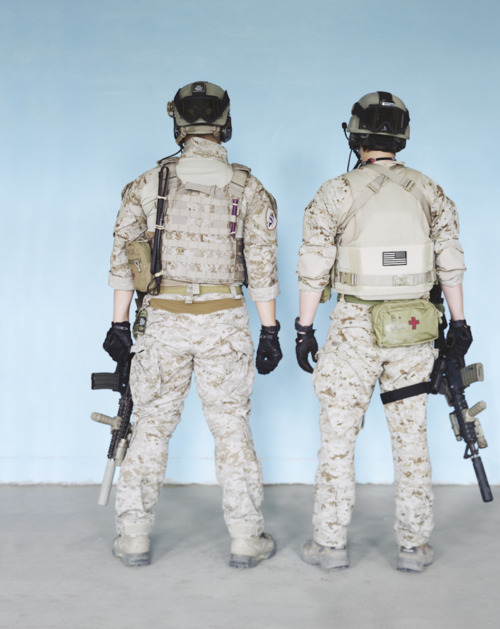
(via blink)
Not sure what the artist Park Dongseok wants to say here, but I found these portraits of Korean war gamers interesting and a little disorientating as they played on my (American) stereotypes of soldiers.
Cy Twombly is dead. He was 83. I saw him at a restaurant once in Rome. I'm happy to report I resisted the strong urge to interrupt his meal.
Rather than read the NY Times survey of his life, I recommend reading interviews. This is a good one to start with.
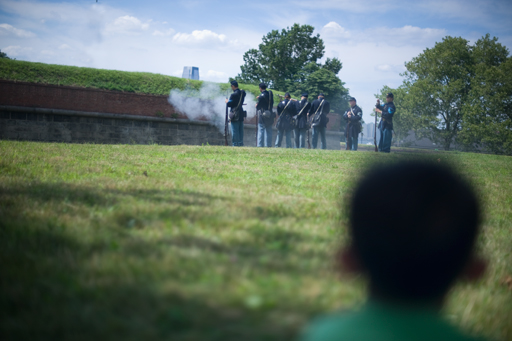
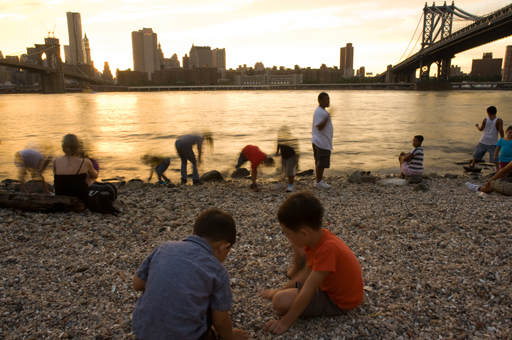
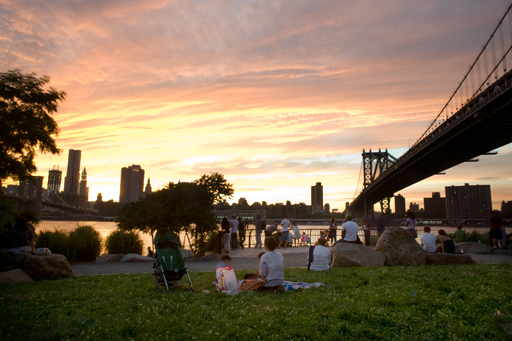
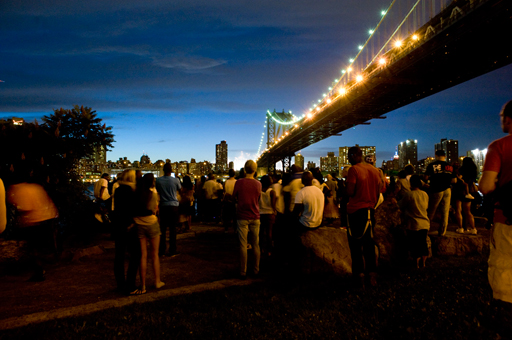
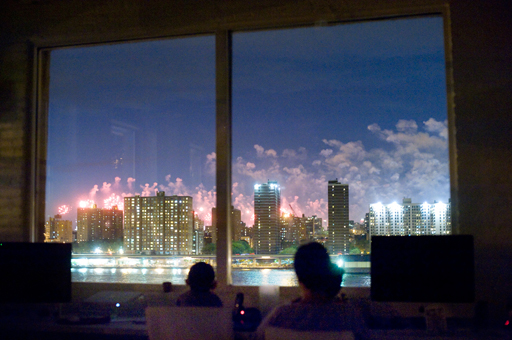

Mike Sinclair always makes somewhat iconic 4th of July pictures (in a way all his pictures are 4th of July pictures), this year is no exception. Click through for the full sized image.
I put my kids to sleep tonight with a story as I do most nights. Tonight's story was to be about a boy who finds a message in a bottle from a shipwrecked sea captain. I often wing stories making them up as I go along, but this one had been gestating for a few days... it was a good one. The kids were in their bunk beds eyes closed and ready.
Me: Once upon a time, before you were born, there was a boy who lived in a little white house on cliff overlooking the sea. Every morning before breakfast, he would walk down the stone steps carved into the wall of the cliff to the a small beach to search for treasures left by the tide.
Gabriel: Did he ever find sea snails? I found one once.
Raul Andres: What about sand dollars?
Me: Yes he found lots of sea snails and sand dollars and even a starfish or two.
Gabriel: Starfish look soft but the are really hard. It's true. Was the boy wearing shoes?
Me: Yes that's true, starfish feel hard and he found a few of those over the years, and no the boy never wore shoes in the summer. Now this boy was walking down the beach when...
Gabriel: Did the boy have a bucket?
Raul Andres: He had to have a bucket to collect all this stuff.
Gabriel: He could just hold everything in his hands.
Raul Andres: But the sea creatures would die.
Gabriel: Dad what was the bucket like?
Me: It was a metal bucket. Anyway, one day...
Gabriel: What color?
Me: It was blue. Do you have any more questions about the bucket?
Gabriel: Did it have any words on it or pictures or anything?
Raul Andres: Gabriel! Let dad finish the story.
Gabriel: But I want to know.
Me: The bucket had a moon on one side. No words.
Gabriel: Was it a big round moon with a face?
Me: Thin crescent. No face.
Gabriel: Did the moon glow in the dark?
Me: Yes, it glowed for when he would collect things by night.
Gabriel: What about stars? Did it have a few stars?
Me: Yes. it had lots. In fact the boy called this bucket his star bucket.
Gabriel: I like that bucket.
Raul Andres: It doesn't even exist Gabriel. It's just a story.
Gabriel: We could make one.... Dad can you make us a star bucket?
Me: I'll try.
Raul Andres: That's no fair. Can I get one too?
Me: Yes, you can get one too, but you have to help paint it...
[at this point the conversation veered in another direction.... but later...]
Gabriel: Remember you promised star buckets.
Me: I said I would try.
Raul Andres: I'll help you paint the stars.
Gabriel: The bucket glows in the dark. Those are my favorite buckets.
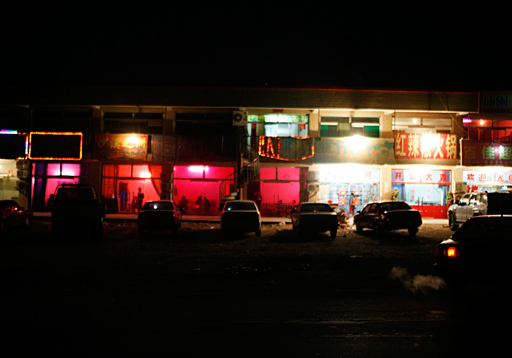
In his Oasis Hotel project Nicolo Degiorgis documents life on the Xinjiang highway that stretches across the Taklamakan. I've travelled the highway a few time and Degiorgis' project gives you a sense of the place. It's often grim. I wish more work was available. This feels more like the beginning of project than something that is fully realized. I hope more is coming...
Monday, June 13
Monterrey: Man hung from a busy overpass and burned
Guadalupe: Butchered man in taxi left at Police Headquarters
Guerrero: 4 gunmen killed in firefight with army
Tabasco: Police confuse famers with gunman, two dead
Chihuahua: Pregnant woman killed by gunman
Acapulco: Man tortured and beheaded
Nayarit: Pregnant woman found badly tortured
Morelia: Executed man discovered
Sunday, June 12
Generan Teran: 3 skinned heads discovered in bags on busy street
Monterrey: beheaded man found in park
Sinaloa: Man tortured and executed in Sinaloa
Canatlan: Father and 2 sons executed
Montemorelos: Armed men open fire in front of Police Station
Excobedo: Violent gun battle, 3 dead
Campesina: 3 men executed at a rehab center
Saturday, June 11
Guerreo: Men killed and skinned, left on highway
Tijuana: Human head discovered
Monterrey: Two men hung from overpass
Monterrey: Man tortured, beheaded
Sinola: Man executed
Nuevo Leon: Butchered man dumped by school
Chihuahua: 3 men gunned down
Guerrero: Warning to Police. Two men skinned. One videotaped before death
Friday, June 10
Sinaloa: Man gunned down in restaurant
Hualahuises: Heads of 3 policeman found
Monterrey: Grenade thrown at State Investigation Agency
Acapulco: Six unmarked graves discovered
Acapulco: Young woman executed
Michoacan: 21 executed
Monterrey: Handcuffed man chased and killed
Vera Cruz: Tortured body of navy man discovered
Thursday, June 9
Guanajuato: Scores of trash bags found with human body parts
Cadereyta: Dismembered woman found
Monterrey: Prison break after grenades are thrown
Monterrey: Police kill two gunman
Chihuahua: Gunman kill three men
Sinaloa: Two young men executed in stolen car
Coahuila: Arsenal discovered
Durango: Police ambushed and executed
Monterrey: Rotting corpse discovered under a bridge
Guerrero: Young Man tortured and burned
Michoacan: 21 bodies found
Santiago: Army attacked by assassins, several dead
Monterrey: Young man executed on busy street
Wednesday, June 8
Monterrey: Woman's Head left at popular restaurant
Victoria: Remains of 30 people found in fuel drums
Chihuahua: Hitmen attack police
Monterrey: Two men hung in broad daylight
Guerrero: Armed group ambush police
Monterrey: Gunbattle in Monterrey
Sinaloa: Armed group attacks and kills three
Guerrero: Two people chased and gunned down
Coahuila: Homemade tank discovered buried in a cave
Tuesday, June 7
Torreon: 11 dead by gunfire.
Guerrero: Body of brutally tortured man found
Tamaulipas: Grenade thrown
Mochicahui: Bullet riddled body of man found
Cadereyta: Bodies of dead men found being eaten by animals
Guadalupe: Two men executed
Monterrey: Beheaded man foudn on street.
Chihuahua: Bodies of two beheaded women discovered
Monterrey: Young man executed in his bedroom
Sinaloa: Policeman and son killed.
Nuevo Leon: Three headless bodies found on the highway
Nuevo Leon: Three heads discovered
Michoacan: Man quartered fond on side of road
Morelos: Running run battle. At least two killed.
Juarez: At least 7 found dead in shallow grave
Monterrey: Officer surrounded and attacked
It's estimated that since 2006 when this drug war ramped up between 30,000 and 40,000 people have died in narco related violence. This is roughly double the total number of estimated deaths (civilian and military) in Afghanistan since 2001.
These headlines were taken from a single blog that covers narco violence. If I were to include accounts from major newspapers and other blogs this list would have been many times longer.
Update: Two days after this was posted between 33-39 people were killed in drug violence in Monterrey. This went largely unreported in American media. To give this context on an average day in New York City which is more than double the size on Monterrey, 1.4 people are murdered.
If you want more background on the drug war in Monterrey, Nik Steinberg's piece The Monster and Monterrey in the Nation is excellent.
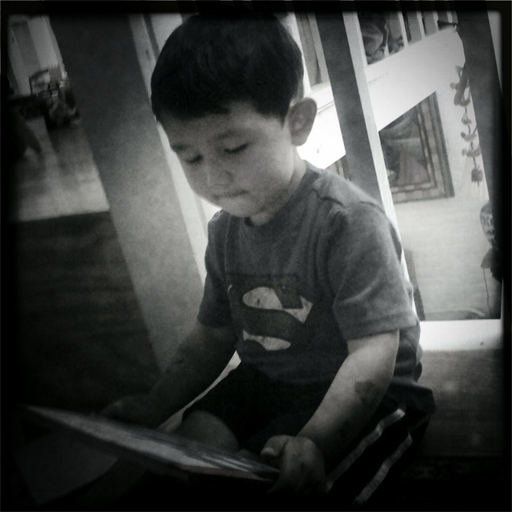
G: Does Louis Armstrong have strong arms?
Me: Yes. Very strong.
G: But not stronger than Superman.
Me: Nope.
G: But he sings better than Superman.
[quiet]
G: I love Louis Armstrong. He is dead though.
--
G on the bus w/ his mom, apropos of nothing.
G: Who is Louis Leakey?
Jenn: He was a famous researcher. Where did you learn about Louis Leakey?
G: What's a researcher?
Jenn: Someone who studies things.
G: Louis Leakey studied fossils.
Jenn: Well he looked for human fossils from people who lived a long time ago.
G: Only humans? No dinosaurs? Right?
Jenn: Only humans.
G: Louis Leakey is dead. He should study his own bones.
 Click the image for a larger version.
Click the image for a larger version.
I see this view every morning when I walk to work. Business Insider posted the middle image by Danny Lyon this morning... (via @kottke)
I have a couple of books of Dayanita Singh's work and am a big fan so I was excited to hear that Radius is publishing a new book titled House of Love. The press release says "House of Love is a work of photographic fiction that takes the form of nine short stories." I've not seen the book yet or the work, but am looking forward to grabbing a copy.
Don't know Singh's work? You can find a few of her images here and on her gallery site. Her books are available through Amazon UK.
When I was a kid, sometimes on hot summer days my abuelito and I would drive in his big American car to Cine Elizondo in the middle of the day and watch movies. I remember seeing westerns, Santo movies, and American films like Herbie the Love Bug dubbed in Spanish. I loved the everything about those days, but the theater made everything extra-special. The air was cold and theater was spectacular, covered in dragons and golden temples. Audiences were loud and enthusiastic and they clapped at the end of each movie. Years later I would visit Grauman's Chinese Theater in Hollywood only to be disappointed by it's relative plainness. I had been ruined.
The Elizondo was torn down in the 80's. Hearing about it from my dad who also loved that theater, I remember thinking it was the end of an era. I thought I would never again experience a movie like that. But then years later I found myself in India, again on a hot day. The food was a little different (samosas and vada), but there was the cool, the fantastic decoration, and the sense that you were experiencing something special.
Zubin Pastakia has been photographing Bollywood movie palaces which it seems are again being destroyed. The pictures make me nostalgic for places I've never seen.
What's not to love about solargraphs—multi-week or month exposure images made by pointing pinhole cameras at the sky and recording the trails left by sun. I've always thought of solargraphs as portraits of time itself.
A Finnish student named Tarja Trygg sends pinhole cameras to "assistants" around the world. They record images and mail the cameras back for processing. Trygg has set up a solargraphy website to showcase the results. Some examples (from Alexandria, Egypt and Tijeras New Mexico respectively):
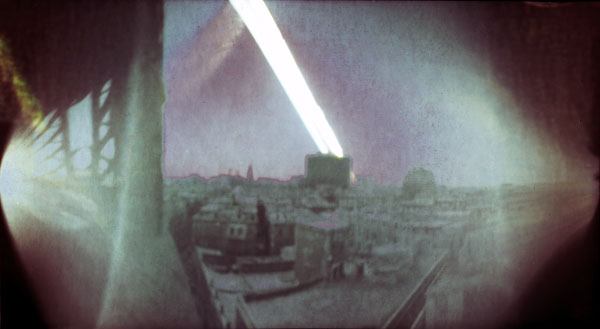
More solargraphy links: Becky Ramotowski's Castle Rock, flickr sologoraphs, Justin Quinnell's widely blogged solargraphs, Michael Wesely
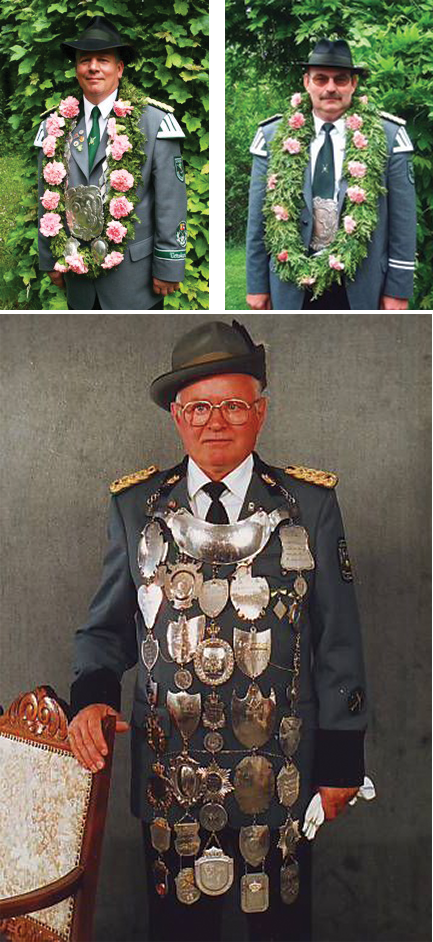
From Mrs. Deane, a wonderful set of images of Schützenkönig or Rifle Kings. Click through for more info and many more pictures.
Want the inside scoop on the North Korean music scene? Check out this this fascinating series of articles by the Guardian collectively titled Pyongyang goes pop.
Related: Music for Maniacs offers an entire album's worth of North Korean tunes.
More North Korea Links: Russian Student in Pyongyang, North Korean Children Playing Changgu, North Korean Stop Motion Animation, North Korea Uncovered (a Google Earth file to heavily annotate the map of North Korea, North Korean Soliders Taking Snapshots, and (my favorite) Kim Jong Il's water slide
Continue reading "Excuse me while I rock out to the Ponchobo Electric Ensemble and The Wangjaesan Light Music Band" →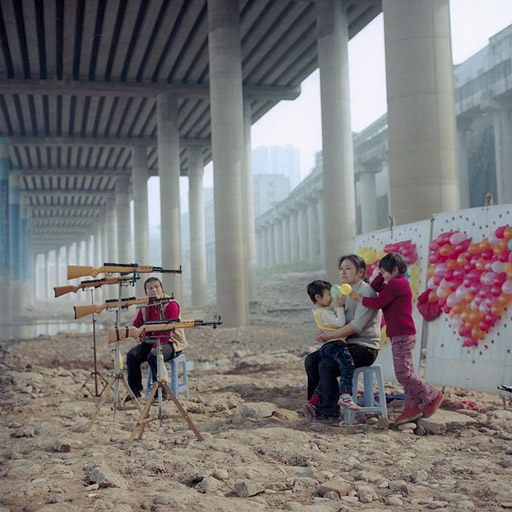
This photographer hails from Chongqing, shoots 6x6, and goes my the name Mirocn. You'll have gleen the rest of the story from the photos themselves.
(via hanna)
p.s. This photographer's work reminds me a bit of 木格's (Mu Ge's) work who is also from Chongqing. Friends? Do they influence know each other? Maybe even the same person?
Are there any Chinese photographers out there who can shed more light on on the great work coming out of these Chongqing natives?
Strict ethnographic portraits are deeply out of favor in academia and yet it's hard to deny that they are compelling. Phyllis Galembo specializes in these portraits very much in the style of 19th century ethnographer's without modern overlay, comment, or idiosyncratic technique; their power is their subject matter.
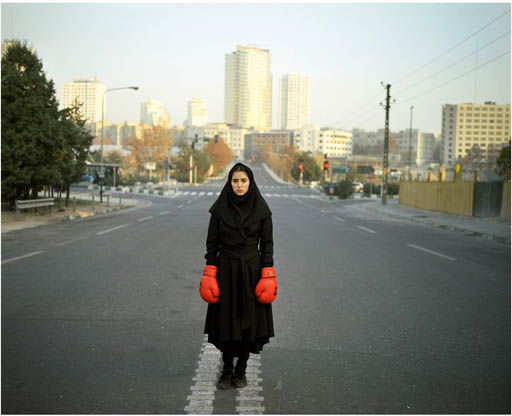
Newsha Tavakolian is a well known photojournalist, but her work has gradually become more metaphorical. She has many projects that challenge assumptions we might have about Iran and Iranian women in particular.
Interesting interview with Ms. Tavakolian from last year where she speaks of being inspired by Naser al-Din, an early Sha of Iran and, apparently, a photography buff.
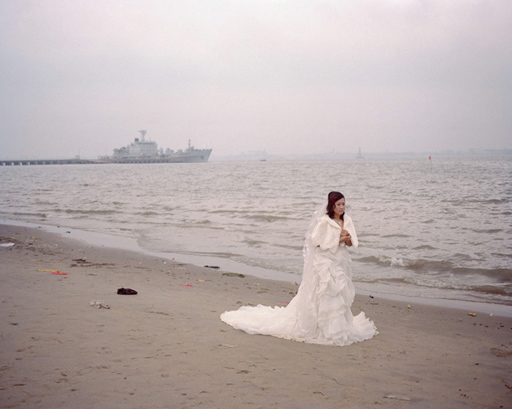
Chengdu based Zhang Xiao produces work that makes me miss China intensely. He also occasionally posts to flickr: Zhang Xiao on flickr.
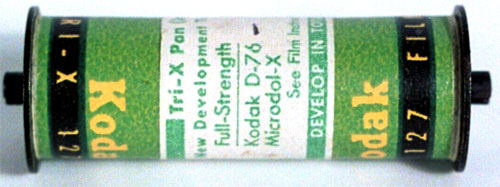
I was looking around for someone to develop 127 film today and came across Film Rescue a company specializing in old film stock development. Even better they've uploaded a huge flickr set of pictures of old film stock. Not pictures on old film stock, pictures of the rolls of film themselves. It's a litmus test of your film geekiness. Double thumbs up over here.
Related: Film Box Group
I love Julia Gillard's Series American Holidays. This one is titled "Labor Day, Detroit Michigan". I wish there she introduced her portfolios. I'd like to hear more about the thinking behind the images.
I'm a big fan of this short set of images by the New York based Belgian photographer Clémence de Limburg on Mali. Her images leave me wanting more, and to dust off my traveling shoes...
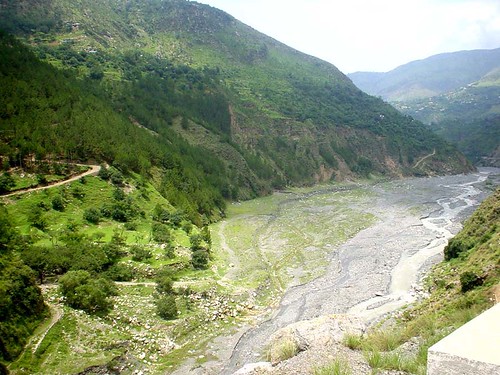
If you are interested in how news starts to follow a narrative especially when facts and boots on the ground are sparse, study the details of the reports on Abbottabad. I happen to have been through Abbottabad as it's on the tail end (or beginning, depending on your direction) of the Karakoram Highway and have a sense of the place. The media has repeatedly defined the city as a suburb of Islamabad (the Pakistani capital) and as a military garrison. Also, interesting, is the description of the house as a mansion/luxury compound and a fortress.
Abbottabad was founded as a British Hill Station, a place where English military officers and officials would escape the heat of cities like Peshawar, Rawalpindi, or Lahore (Islamabad, the Pakistani equivalent of Brazillia, didn't exist yet). The city is a popular tourist destination, weekend getaway, and honeymoon spot for middle and upperclass Pakistanis. THE honeymoon spot is another town called Murree which is higher in the mountains, Abbottabad is sort of a second tier spot.
The city is about 100 km from Islamabad over a road that takes roughly two hours to drive if the traffic isn't terrible which it often is. Many news organizations are reporting the distance between Islamabad and Abbottabad by drawing a straight line on a map without looking at topography. The straight line from Islamabad to Abbottabad crosses very high mountains. The road that actual people travel takes a more circuitous route.
A big prestigious military academy sits on the north side of the town and lots of military folks build retirement and vacation homes there. This is mainly because the Pakistani brass have the the type of money/sway to build houses in popular vacation spots. If you show up in the town center you wouldn't think of the town as being any more or less of military town than any other town in the region (the military has a heavy presence throughout the area). All the cities here have a large number of tribal people and the central government needs the military to reign them in.
Much has been made of the fact that the military owns lots of land in the town, and that the compound couldn't have been built without the military's knowledge, but just as almost everywhere in Pakistan, a little baksheesh greases the wheels and helps avoid questions.
Many if not most of the large homes in the middle and upper middle class areas are surrounded by high walls (often topped by barbed wire or broken glass). Many many multi-family compounds are scattered throughout the city. As far as mansions go, I've seen much nicer looking homes in Pakistan. I presume the primary reason this house stuck out for the intelligence guys was that the size of the house didn't fit the profile of the people who were supposedly living inside it. The lack of phone and internet would also be unusual, but probably not unheard of (many people in Pakistan only use cell phones, and many people, even wealthy ones, are unwired).
A few other impressions: Abbottabad is also something of a college town with dozens of small colleges. Many students would be considered Westernized liberals in Pakistan. One legacy of the British occupation is a sizable Christian population. I distinctly remember hearing church bells in the town. There are still several prominent churches scattered about.
Here are some media characterizations of the city:
"garrison suburb of Abbottabad, about 30 miles from the center of Islamabad" - National Review"Abbottabad is essentially a military cantonment city in Pakistan, in the hills to the north of the capital of Islamabad, in an area where much of the land is controlled or owned by the Pakistan Army and retired army officers." - New Yorker
"U.S. forces for months had watched the luxury compound in Abbottabad, a city 65 miles from the capital that is home to two Pakistani army regiments" - Washington Post
'"Mansion? Next to a military base? 18 miles from the capital? Staying there for three years?" he said.' - USA Today
" Mr. bin Laden was killed Sunday in a targeted assault in the Pakistani city of Abbottabad, roughly 40 miles outside the capital city of Islamabad." - Wall Street Journal
A more accurate representation:
In August 2010, the intelligence agencies found the exact compound where this courier was living, in Abbottabad. That home was in an affluent suburb of a nondescript garrison town, perhaps selected for its very anonymity and, of course, its good communications and ease of access to the tribal zones. - The Guardian
It will be interesting to see how the picture of the town morphs over time.
Photoset of images from Abbottabd
Flickr photos from Abbottabad, More pictures from a Pakistani journalist
Without realizing it, Sohaib Athar, a Pakistani IT Professional from Lahore on a retreat in the vacation town of Abbottabad, live tweeted the 1am arrival of helicopters in the raid that killed Bin Laden.
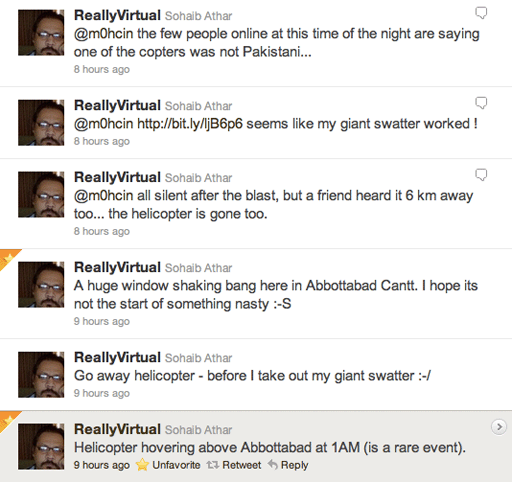
Other interesting tweets from the area: Another live-ish tweet, It was a known militant hideout, Supposed Post Mortem Picture of Osama circulating in Pakistan (Tin Eye confirms it's a fake- circulating since last year), Some thought helicopter crash was a bomb, lots of choppers, Another local report
Pakistan's English Language Newspaper
Update: Video from a Neighbor

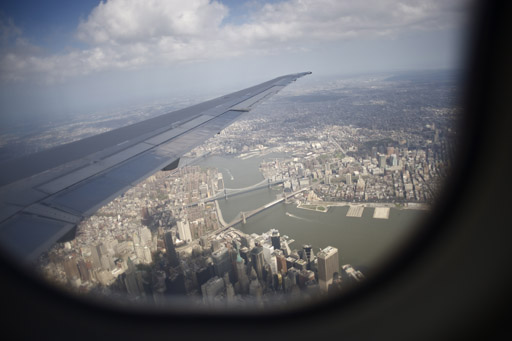

If you are interested in food, endangered species, epidemiology, or modern China I recommend seeking out Karl Taro Greenfeld's 2005 Paris Review essay on Guangzhou's 'wild flavor' bush meat restaurants. An excerpt:
Now this style of dining, which was once a quaint local custom, had become industrialized. In one cage at Xinyuan I counted fifty-two cats packed so tightly that their guts were spilling out between the wire bars. There were fifty such cages in that stall. There were fifty-two stalls along that row of vendors. There were six rows of vendors in that market. And there were seven markets on that street. A sharp, musky smell overwhelmed me—the excrement of a thousand different animal species mingling with their panicked breath. I saw at least a dozen types of dogs, including Labradors and Saint Bernards, and there had to be at least as many different breeds of house cat. There were raccoons, dogs, badgers, civets, squirrels, deer, boars, rats, guinea pigs, pangolins, muskrats, ferrets, wild sheep, mountain goats, bobcats, monkeys, horses, ponies, and a camel out in the parking lot. And these were just the mammals. The choice of birds and reptiles was every bit as diverse. Predator was sometimes stacked atop prey. Damaged animals—those that had lost a paw, say—were kept alive with intravenous drips. And because wild animals were more valuable than farm-raised creatures, I was told that some traders would slice off the hind paw of a civet or badger to make it appear to potential buyers that the animal had been trapped in the wild.I had brought a list of banned animals from the Wild Animal Protection Office. I asked for the rare bird species, the monkeys, the tigers.
“No problem,” I was told by a smiling trader with buckteeth who said he was from Guangxi.
“What about the authorities?” I asked.
“No problem.” He pointed to a fellow in a gray and blue uniform sitting on a white plastic chair, flicking his cigarette ashes by a bag of banned snakes.
“OK, how about mountain lion?”
“No problem.”
“Black bear?”
“No problem.”
I decided to push my luck.
“How about panda?”
He shook his head. “You must be sick.”
The entire article is available in this back issue of the review, as a chapter of the excellent
The Best Creative Nonfiction, Vol. 1, and as a portion of China Syndrome: The True Story of the 21st Century's First Great Epidemic (which I haven't read but plan to!).
What to do about an old journal?
Blank save for three overwrought pages from 1987 (full of intrigues from forgotten parties) and a small set of drawings (labeled December 1988 of a mountain in Mexico — the view from my abuelito's window).
Then, apparently, nothing. Forgotten until tonight.
Bound in hand tooled chocolaty leather and adorned with hand annotated vintage maps pasted onto the end pages by me, it is a handsome volume — the kind of thing a twenty year old me would think proper to keep on a desk. Inside, the blank unruled pages hate being empty... and I am eager to fill them...
And yet... the emptiness speaks of the years between here and there, so I hesitate.
Hmmm.
Agence Eureka has quickly become one of my favorite sources for visual inspiration. The site features French printed material from the 20's-70's. A few examples: children's games, type samples, vintage costume patterns and on and on...
Rona Chang is a Queens based Chinese photographer working on several ambitious projects investigating man's control (or lack of control) of nature. She writes, "It is the intersection of human, climatic, and geographic realms that are contemplated in my photography." Her image sequencing disorients us (intentionally I believe) by juxtaposing images connected by ideas rather than location. This is work I'd much rather see in person than on the web. Show please.(via flak)